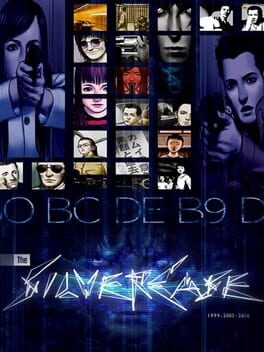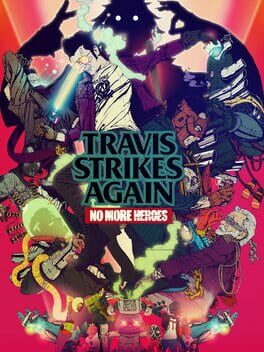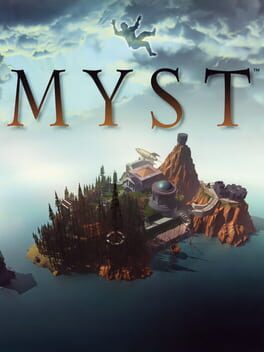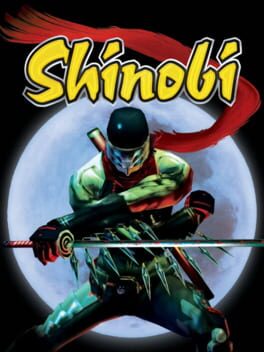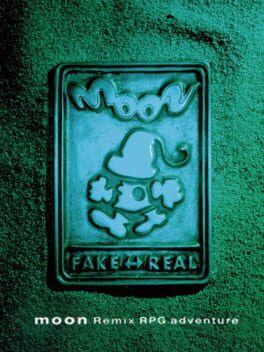Hattori
2016
Playing through The Silver Case with only the knowledge that it is a Visual Novel and one of Suda's early works, one doesnt expect to find MGS2 conceived years before the MGS2 we actually know today. It's hard to adjust to The Silver Case if you never have played Visual Novels before. You will spend hours reading lines of text and dialogue, occasionally moving around a bit to find the next set of text and dialogue, watching static portraits of the characters with the rare still showing you what is indeed happening, and a puzzle once in a blue moon to solve, all while you repeatedly mash the spacebar to move the story along.
Playing TSC, questions of what constitutes a videogame and if VNs can even fit that role inevitably arise, and sometimes the lack of interactivity or choice makes one wonder why you arent simply just reading a book. But like Kojima, Suda understands that when the player controls a character in an interactive medium, a symbiotic relationship is created between both, constantly shifting from one to the other and to what's inbetween, and he takes advantage of that knowledge to play with complex postmodern ideas of identity, your place in the world, the search for truth, the age of information, purpose, freedom of choice, and so much more.
Suda's writting style is wholly unique, something fans of Killer7 and NMH can testify to, filling TSC with a lot of dense questions and mysteries delivered in very obtuse and uncoventional ways, most of which you will never find the answers to, and a vast and diverse cast of characters with their own quirks and weirdness, and seemingly incomplete and questionable arcs. And he delivers these with just enough interactive input from the player, while at the same examining said player's role and what that implies, that by the end of the game, the existence of TSC as a videogame is totally justified. What starts as a cynical and edgy conspiracy about an elusive worshiped mass murderer, slowly leads into a surreal abstract canvas where the existence of a main villain is no longer as certain as it was at the beginning, becoming instead a heartfelt and empathetic mirror held to the videogame players of the modern age. A game truly ahead of it's time.
Playing TSC, questions of what constitutes a videogame and if VNs can even fit that role inevitably arise, and sometimes the lack of interactivity or choice makes one wonder why you arent simply just reading a book. But like Kojima, Suda understands that when the player controls a character in an interactive medium, a symbiotic relationship is created between both, constantly shifting from one to the other and to what's inbetween, and he takes advantage of that knowledge to play with complex postmodern ideas of identity, your place in the world, the search for truth, the age of information, purpose, freedom of choice, and so much more.
Suda's writting style is wholly unique, something fans of Killer7 and NMH can testify to, filling TSC with a lot of dense questions and mysteries delivered in very obtuse and uncoventional ways, most of which you will never find the answers to, and a vast and diverse cast of characters with their own quirks and weirdness, and seemingly incomplete and questionable arcs. And he delivers these with just enough interactive input from the player, while at the same examining said player's role and what that implies, that by the end of the game, the existence of TSC as a videogame is totally justified. What starts as a cynical and edgy conspiracy about an elusive worshiped mass murderer, slowly leads into a surreal abstract canvas where the existence of a main villain is no longer as certain as it was at the beginning, becoming instead a heartfelt and empathetic mirror held to the videogame players of the modern age. A game truly ahead of it's time.
1995
In the pantheon of what people consider "perfect games", it's not gonna be hard finding Chrono Trigger being name-dropped.
Playing it all these years later, it's understandable to see why it has such a highly regarded reputation. Chrono Trigger moves along at a brisk and well thought out pace, establishing its world, tone, and characters in a few short and memorable scenes, right before sending you off on a time travel adventure to save the planet from ultimate annihilation with your best friend and a damsel in distress.
This is Chrono Trigger's biggest strength: the ability to not waste your time, presenting a compelling and fun diverse cast of personalities and enough intrigue and pathos to propel you on your quest. This is accomplished by the expertise of Square Enix's "Dream Team", a group of talented devs that included Sakaguchi (titan of the JRPG genre, famed for creating Final Fantasy), Toriyama (the man behind the iconic character design of Dragon Quest) and Uematsu (legend composer of the Final Fantasy series), along with other just as important members, who gave Chrono Trigger its classic art style and design, charming and witty dialogue and characters, a memorable and haunting soundtrack, and engaging combat system.
Beyond the bond and interplay between the main characters that happen during the cutscenes, the combat itself also reinforces that narrative, with its focus on cooperative techniques that have the team members joining together to deal more powerful attacks to the enemies. Added to that, the combat isn't as abstracted as other JRPGs like Final Fantasy, where the characters and enemies just stand in direct opposition to each other, statically waiting for their turn.
In Chrono Trigger you can see the enemies walking around in the field before encounters, and during combat they move around and are affected by their position in relation to your team members, creating a much more dynamic and expressive burst of action.
Chrono Trigger doesn't' necessarily push the boundaries of its main core components. The story is enjoyable all the way through, but it's not the greatest literature ever put on a cartridge, and the gameplay is satisfying enough but it's not gonna break the mold of JRPGs anytime soon. It's however the marriage between all its pieces that produce a blockbuster of 16-bit glory.
It's hard not feel some form of fascination and excitement during moments like when you are showing Marlie around the town fair, when you find yourself transported to the future and witness the world destroyed, when you fight Magus in his dark castle, when you find the lost magic kingdom that's suspended in the air, or when you save a team member who sacrifices himself to save the rest of the group from certain death.
As you find yourself at the end, having gone through space and time fighting a gauntlet of enemies and boss battles, and defeating a challenging and multiple phased final boss, it's difficult not to look back at the game and not be impressed by it's perfected simplicity.
Regarding which version to be played, the SNES is the right decision. The DS version, while more faithful, does a disservice to the characters by making the line delivery more stoic and stilted, and the game is intended to be played on a big screen, not on such a small device where the pixel magic will be lost.
Certified classic.
Playing it all these years later, it's understandable to see why it has such a highly regarded reputation. Chrono Trigger moves along at a brisk and well thought out pace, establishing its world, tone, and characters in a few short and memorable scenes, right before sending you off on a time travel adventure to save the planet from ultimate annihilation with your best friend and a damsel in distress.
This is Chrono Trigger's biggest strength: the ability to not waste your time, presenting a compelling and fun diverse cast of personalities and enough intrigue and pathos to propel you on your quest. This is accomplished by the expertise of Square Enix's "Dream Team", a group of talented devs that included Sakaguchi (titan of the JRPG genre, famed for creating Final Fantasy), Toriyama (the man behind the iconic character design of Dragon Quest) and Uematsu (legend composer of the Final Fantasy series), along with other just as important members, who gave Chrono Trigger its classic art style and design, charming and witty dialogue and characters, a memorable and haunting soundtrack, and engaging combat system.
Beyond the bond and interplay between the main characters that happen during the cutscenes, the combat itself also reinforces that narrative, with its focus on cooperative techniques that have the team members joining together to deal more powerful attacks to the enemies. Added to that, the combat isn't as abstracted as other JRPGs like Final Fantasy, where the characters and enemies just stand in direct opposition to each other, statically waiting for their turn.
In Chrono Trigger you can see the enemies walking around in the field before encounters, and during combat they move around and are affected by their position in relation to your team members, creating a much more dynamic and expressive burst of action.
Chrono Trigger doesn't' necessarily push the boundaries of its main core components. The story is enjoyable all the way through, but it's not the greatest literature ever put on a cartridge, and the gameplay is satisfying enough but it's not gonna break the mold of JRPGs anytime soon. It's however the marriage between all its pieces that produce a blockbuster of 16-bit glory.
It's hard not feel some form of fascination and excitement during moments like when you are showing Marlie around the town fair, when you find yourself transported to the future and witness the world destroyed, when you fight Magus in his dark castle, when you find the lost magic kingdom that's suspended in the air, or when you save a team member who sacrifices himself to save the rest of the group from certain death.
As you find yourself at the end, having gone through space and time fighting a gauntlet of enemies and boss battles, and defeating a challenging and multiple phased final boss, it's difficult not to look back at the game and not be impressed by it's perfected simplicity.
Regarding which version to be played, the SNES is the right decision. The DS version, while more faithful, does a disservice to the characters by making the line delivery more stoic and stilted, and the game is intended to be played on a big screen, not on such a small device where the pixel magic will be lost.
Certified classic.
For anyone who follows Suda 51, it's obvious that he puts much of himself and his life experiences into his own work. His games are filled with paralels to himself, his thoughts, ideas, opinions, and everything else inbetween, creating a very distinct series of games that are not only intertwined by a common theme (The past) but also by Suda.
Travis Strikes Again is the most blatant example of this dynamic, putting Suda directly into the shoes of Travis Touchdown, a once rising star in the world of assassins, now a washed up and reclusive hermit jaded by his previous existence.
TSA is steeped in love for the primitive and wild west origins of videogames that Suda was lucky to be a part of, recontextualized through the modern indie scene that revitalized not only the uncharted territory of the videogame creation process, but Suda himself.
TSA is a myriad of references, introspections, observations and jabs at Suda's past work and his participation in the creation of those, constructing a surprisingly heartfelt and personal redemption arc for both Travis Touchdown and Suda.
To accomplish this feat, TSA is presented as a indie looking top view hack n' slash beat em up reminiscent of old school arcade titles, where Travis goes inside a videogame console to fight through stages and bosses of videogames he played at an early age and that made him the man he is now, this too interconnected with Suda's past.
The gameplay itself isnt anything worthy of writing home about, it gives you just enough to be entertained all the way through its length and provides a nice challenge to overcome. Of all the Suda action oriented games, it's probably the least interesting one gameplay-wise, functioning more so as an intersection between the the narrative meat of the game.
But if you have played Suda games before, you know that the gameplay is never the main focus of the experience, but a vehicle for something greater than the sum of its parts. And to be able to fully appreciate this title, you have to be already invested in the Suda 51 canon. Otherwise, this game might not speak much to you, understandably so.
A fantastic transitional step for Suda, and im looking forward for what's next to come.
Travis Strikes Again is the most blatant example of this dynamic, putting Suda directly into the shoes of Travis Touchdown, a once rising star in the world of assassins, now a washed up and reclusive hermit jaded by his previous existence.
TSA is steeped in love for the primitive and wild west origins of videogames that Suda was lucky to be a part of, recontextualized through the modern indie scene that revitalized not only the uncharted territory of the videogame creation process, but Suda himself.
TSA is a myriad of references, introspections, observations and jabs at Suda's past work and his participation in the creation of those, constructing a surprisingly heartfelt and personal redemption arc for both Travis Touchdown and Suda.
To accomplish this feat, TSA is presented as a indie looking top view hack n' slash beat em up reminiscent of old school arcade titles, where Travis goes inside a videogame console to fight through stages and bosses of videogames he played at an early age and that made him the man he is now, this too interconnected with Suda's past.
The gameplay itself isnt anything worthy of writing home about, it gives you just enough to be entertained all the way through its length and provides a nice challenge to overcome. Of all the Suda action oriented games, it's probably the least interesting one gameplay-wise, functioning more so as an intersection between the the narrative meat of the game.
But if you have played Suda games before, you know that the gameplay is never the main focus of the experience, but a vehicle for something greater than the sum of its parts. And to be able to fully appreciate this title, you have to be already invested in the Suda 51 canon. Otherwise, this game might not speak much to you, understandably so.
A fantastic transitional step for Suda, and im looking forward for what's next to come.
1993
Booting up Myst 27 years later after it's release, it's still impressive how much mystique and allure it has.
It's age immediately shows, but once you get past it's early cd-rom origins, you will find yourself in its now emblematic otherwordly, alien and mysterious island.
The static nature of its gameplay, combined with the lack of living beings on the island ( besides the presence of live action clips of the previous inhabitants and their belongings and writing) and sparse ambient soundscape creates a very unique and zen like atmosphere that's hardly replicated on other games of it's genre, something that probably helped it standout so much at the time. The obtuse and illogical mechanisms, buttons and contraptions scattered across the world of Myst invite the player like a moth to fire, speaking to a inner part of human nature that wants to solve and make sense of things.
The brilliance of it's design is in how it has every solution and path available to you from the start, you just dont have the information and clues required to know that those solutions and paths are already in front of you. In a stroke of genius, the game even has the final solution in plain sight at the start of the game. Some of the puzzles are duds, and some of the puzzles are a bit too obtuse to be taken seriously. The story is barebones, and only there to serve as some form of goal. There is sometimes the sense that you are playing a tech demo for the almight CD-ROM.
But Myst is still a classic, and if you never have, you should visit it's island and see for yourself the power of human curiosity and stubborness, and how that alone is enough to create a world worth falling into.
It's age immediately shows, but once you get past it's early cd-rom origins, you will find yourself in its now emblematic otherwordly, alien and mysterious island.
The static nature of its gameplay, combined with the lack of living beings on the island ( besides the presence of live action clips of the previous inhabitants and their belongings and writing) and sparse ambient soundscape creates a very unique and zen like atmosphere that's hardly replicated on other games of it's genre, something that probably helped it standout so much at the time. The obtuse and illogical mechanisms, buttons and contraptions scattered across the world of Myst invite the player like a moth to fire, speaking to a inner part of human nature that wants to solve and make sense of things.
The brilliance of it's design is in how it has every solution and path available to you from the start, you just dont have the information and clues required to know that those solutions and paths are already in front of you. In a stroke of genius, the game even has the final solution in plain sight at the start of the game. Some of the puzzles are duds, and some of the puzzles are a bit too obtuse to be taken seriously. The story is barebones, and only there to serve as some form of goal. There is sometimes the sense that you are playing a tech demo for the almight CD-ROM.
But Myst is still a classic, and if you never have, you should visit it's island and see for yourself the power of human curiosity and stubborness, and how that alone is enough to create a world worth falling into.
2002
If you would have played this game without any context of its predecessors or the knowledge of its name title, you probably would never associate Shinobi for the PS2 with the classic Shinobi series of the 90s. Looks can however be deceiving, as this entry is extremely similar to those older games, both in aesthetics and gameplay philosophy.
Shinobi is a very arcade-y and fast paced game thats centered on its main combat mechanic: the more enemies you kill in a short time frame, the more damage you do to subsequent ones. Despite there only being one main attack button, a button for throwing shurikens that stun enemies and a dodge button, this timed gimmick manages to carry the whole game all the way through the end, going as far as letting you literally one hit kill every single boss in the game if you play your cards right.
The developer team was smart in stripping away any fat from the game, like complex combos or any needless moves that would only distract you from the main conceit of the game, which is getting through the stages as fast as possible. With this speed and precision focused combat system, its selection of oriental flavored environments mixed with industrial and sci fi thematic locations, and a dash of ninja style by letting you run on wall, this entry in the series feels right at home with the 2D predecessors, despite what its deceiving exterior might look like.
It falls a bit short from achieving greatness due to some lackluster and dull enemies, a frustrating camera, a couple of mediocre levels, a terribly uninteresting story and some infuriating bosses, but if you are looking to scratch that action game itch, then Shinobi is a hidden gem waiting to be mastered, with a very appetizing runtime of around 5 hours, allowing for multiple replays.
Plus, you have to admit that the scarf is badass.
Shinobi is a very arcade-y and fast paced game thats centered on its main combat mechanic: the more enemies you kill in a short time frame, the more damage you do to subsequent ones. Despite there only being one main attack button, a button for throwing shurikens that stun enemies and a dodge button, this timed gimmick manages to carry the whole game all the way through the end, going as far as letting you literally one hit kill every single boss in the game if you play your cards right.
The developer team was smart in stripping away any fat from the game, like complex combos or any needless moves that would only distract you from the main conceit of the game, which is getting through the stages as fast as possible. With this speed and precision focused combat system, its selection of oriental flavored environments mixed with industrial and sci fi thematic locations, and a dash of ninja style by letting you run on wall, this entry in the series feels right at home with the 2D predecessors, despite what its deceiving exterior might look like.
It falls a bit short from achieving greatness due to some lackluster and dull enemies, a frustrating camera, a couple of mediocre levels, a terribly uninteresting story and some infuriating bosses, but if you are looking to scratch that action game itch, then Shinobi is a hidden gem waiting to be mastered, with a very appetizing runtime of around 5 hours, allowing for multiple replays.
Plus, you have to admit that the scarf is badass.
It's not hard to see why many would compare Moon to the Mother games, a series of titles that has been poking fun at the tropes and conventions of JRPGs, and videogames in general, starting at 1989, through the use of cute westernized cartoony aesthetics.
However, Moon stands out from those games by how far it goes along with its premise, making use of a subversive and unique game concept and design. By looking at the landscape of videogames in Japan at the time of it's release through the lens of a western adventure game, Moon examines what games are, how we play and perceive them, and what they could be.
3 years ahead of Majora's Mask, Moon presents a world with characters that exist beyond your presence and interference, and that asks you to to simply take a moment, look around, and take note of what you can see. What you will see from it will depend on how much you are willing to give to it, and it's an uncompromising experience that demonstrates the power of videogames, without having to pander to the basic instincts and urges from it's players.
All done through quirky and charming characters, creative and off the wall puzzles, an ecclectic and diverse soundtrack and inventive game design.
Playing Moon, the similarities with Undertale are obvious, and its clear where Toby Fox got a lot of his inspiraton from. And just like Undertale, Moon revels in the use of some of the best meta narrative ideas and conepts the medium has to offer.
But its important to note that Moon did it first. And arguably did it better.
However, Moon stands out from those games by how far it goes along with its premise, making use of a subversive and unique game concept and design. By looking at the landscape of videogames in Japan at the time of it's release through the lens of a western adventure game, Moon examines what games are, how we play and perceive them, and what they could be.
3 years ahead of Majora's Mask, Moon presents a world with characters that exist beyond your presence and interference, and that asks you to to simply take a moment, look around, and take note of what you can see. What you will see from it will depend on how much you are willing to give to it, and it's an uncompromising experience that demonstrates the power of videogames, without having to pander to the basic instincts and urges from it's players.
All done through quirky and charming characters, creative and off the wall puzzles, an ecclectic and diverse soundtrack and inventive game design.
Playing Moon, the similarities with Undertale are obvious, and its clear where Toby Fox got a lot of his inspiraton from. And just like Undertale, Moon revels in the use of some of the best meta narrative ideas and conepts the medium has to offer.
But its important to note that Moon did it first. And arguably did it better.
